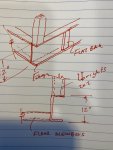HAF
Active member
In the metal fabrication world, many materials are "formed". For example, a channel shape can be made by extruding aluminum through a die. However, there is a lot of excess materials in an extruded channel which makes it very heavy. While an extruded channel may be well suited for structural uses, its may not be very well suited in the construction of a mobile product that needs to be light in weight. The solution is found in forming. I used a formed channel with 2" toes and 12" height-hence a formed 2 x 12 channel.
Cross sectional area is what produces strength and rigidity. Sketch shows how the walls and floor members are tied together. The frame is extremely rigid. The vertical area above floor members provides a massive area for glueing composites or ?
Cross sectional area is what produces strength and rigidity. Sketch shows how the walls and floor members are tied together. The frame is extremely rigid. The vertical area above floor members provides a massive area for glueing composites or ?

